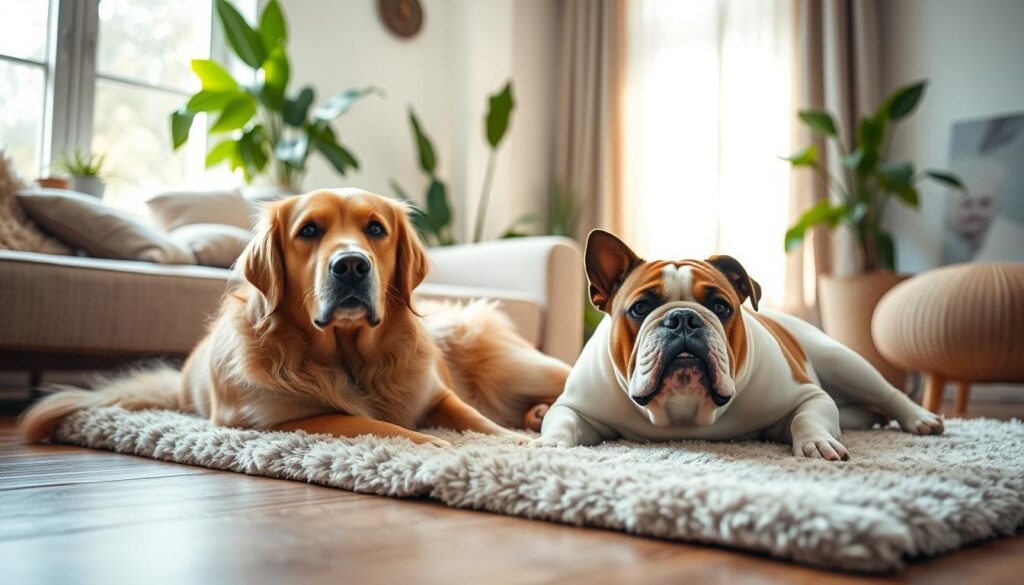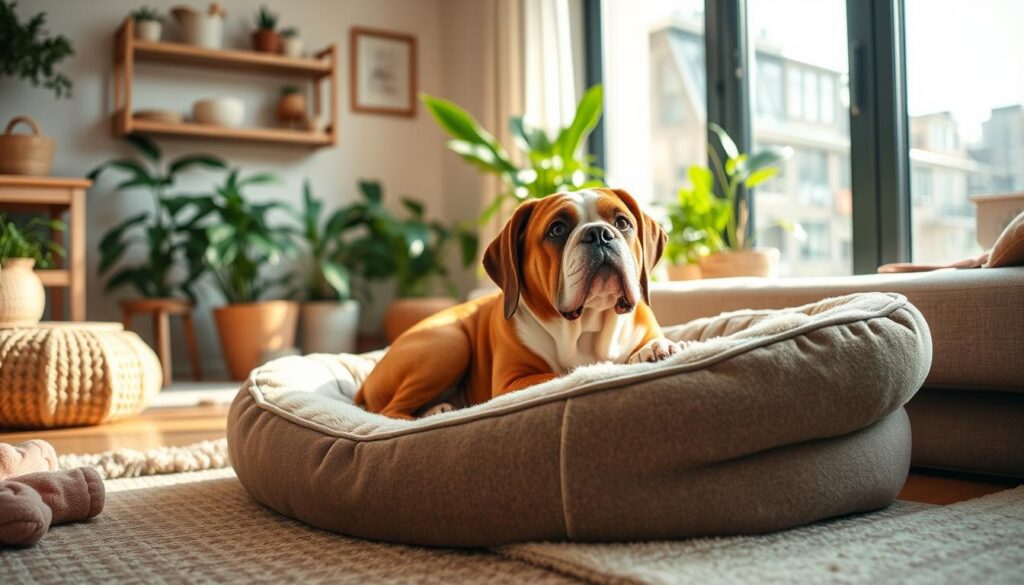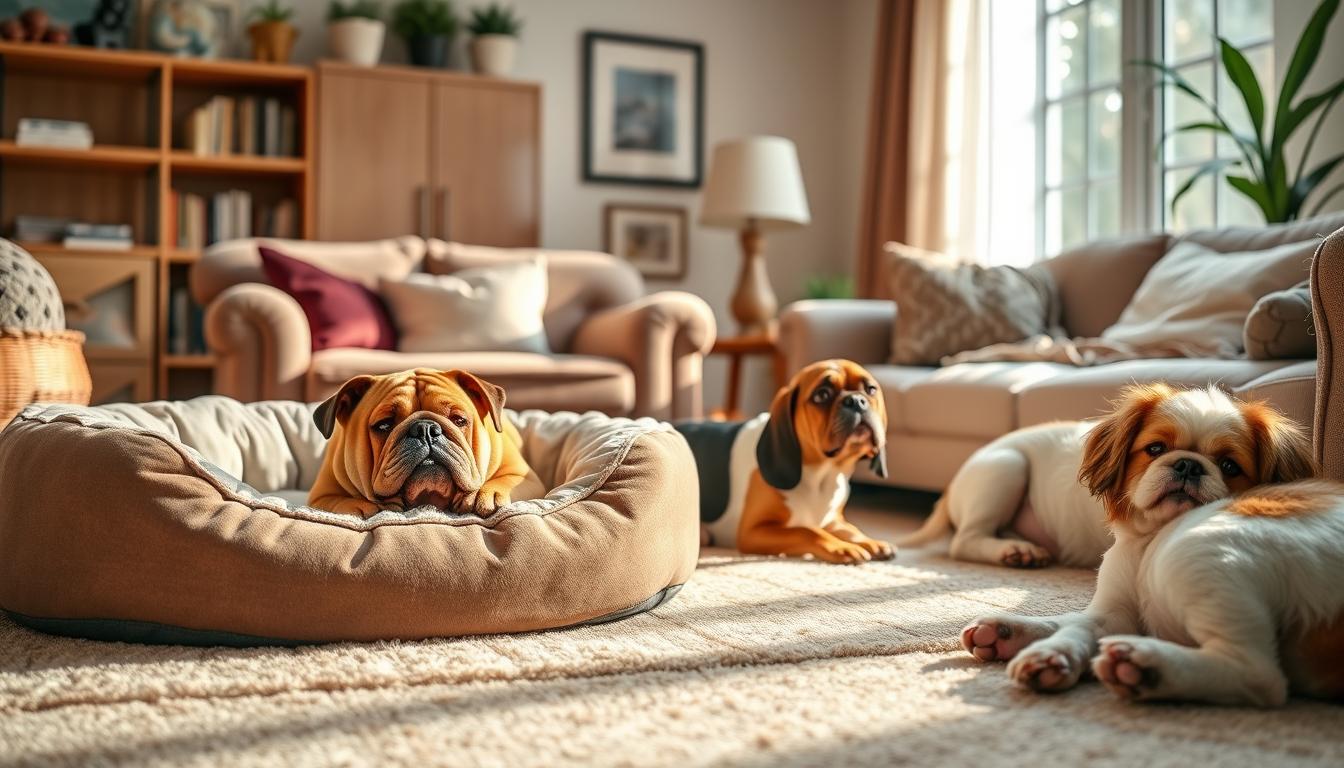Low Energy Dog Breeds Imagine coming home to a furry friend who loves to snuggle up next to you. They don’t need endless activity or attention. If you want a peaceful life, low energy dog breeds might be just right for you. These dogs are happy in calm places, making your home feel more serene.
Looking for a pet that’s easy to care for? These dogs are perfect for busy lives or small homes. They come in all sizes, from tiny to larger breeds. There’s a relaxed dog for everyone, fitting right into your lifestyle.
Key Takeaways
- Low energy dog breeds are well-suited for relaxed living environments.
- These calm companions require less exercise and are content with a more sedentary lifestyle.
- Apartment dwellers and busy professionals can benefit from the low-maintenance nature of relaxed dog breeds.
- Senior-friendly calm dogs can provide companionship without the high-intensity demands.
- Choosing the right low energy breed can ensure a harmonious and stress-free pet ownership experience.
Understanding What Makes a Dog Breed Low Energy
Low energy dogs have several key traits that make them calm. Their physical build and behavior set them apart from high-energy dogs. These traits make them perfect for a relaxed home.
Physical Characteristics of Calm Dogs
Low-energy dogs often have a sturdy build. They have a broad chest and strong legs. This body type makes them less likely to want to run around a lot.
Behavioral Traits of Relaxed Breeds
These dogs are also known for their calm nature. They are less excitable and enjoy just hanging out. They don’t need to be always on the go.
Energy Level Classification System
Experts have created systems to classify dogs by energy level. Dogs are grouped into low, medium, and high-energy levels. This helps find the right dog for your lifestyle.
| Breed | Energy Level | Ideal Living Environment |
|---|---|---|
| Bulldog | Low | Apartment or small home |
| Cavalier King Charles Spaniel | Medium | Apartment or small home |
| Greyhound | High | Larger home with access to ample exercise |
Knowing what makes a dog low energy helps choose the right pet. Understanding their physical and behavioral traits is key. This ensures a good match for a calm home.
Benefits of Choosing a Low-Maintenance Dog
Thinking about getting a dog but worried about the work? Low energy dog breeds are perfect. They are easy to care for and fit well into busy lives.
These dogs need less exercise than others. They’re happy with short walks or playtime each day. This is great for people living in apartments, seniors, and those with busy jobs.
Low energy dogs also need less grooming. They have short coats that are easy to brush and bathe. This saves you time and effort, making them great pets for those who don’t want to spend a lot of time grooming.
These dogs are calm and fit into many homes well. They don’t bark a lot or chew things up, which is good for small spaces or shared homes. This means you can have a pet without disrupting your life or bothering your neighbors.
“Choosing a low-maintenance dog breed can significantly simplify your life, allowing you to focus more on enjoying your pet’s company rather than worrying about their high-maintenance needs.”
Low energy dog breeds are great for anyone who wants a pet but doesn’t have a lot of time. They need less exercise, are easy to groom, and fit into many homes. They offer a stress-free and rewarding pet experience.
Top Low Energy Dog Breeds for Apartment Living
Living in a cozy apartment means finding the right dog breed is key. There are many low energy dog breeds that do well in small spaces. They offer companionship and a calming presence without needing lots of exercise or outdoor space.
Small Space-Friendly Breeds
Size is important for apartment living. Small dog breeds like the Cavalier King Charles Spaniel, French Bulldog, and Bichon Frise are great for small spaces. They love to curl up on the couch and don’t need a big backyard to be happy.
Noise Level Considerations
Apartment dwellers need to think about a dog’s barking and howling. It can disturb neighbors. Quiet dog breeds like the Basenji, Greyhound, and Whippet bark less, making them perfect for living close to others.
Exercise Requirements in Limited Spaces
All dogs need some exercise, but low energy breeds need less. The Bulldog, Pug, and Boston Terrier are examples of dogs that do well with short walks and playtime at home. They don’t need to go outside for hours.
| Breed | Size | Noise Level | Exercise Needs |
|---|---|---|---|
| Cavalier King Charles Spaniel | Small | Moderate | Low |
| French Bulldog | Small | Low | Moderate |
| Bichon Frise | Small | Moderate | Low |
| Basenji | Small | Low | Moderate |
| Greyhound | Medium | Low | Moderate |
| Whippet | Medium | Low | Moderate |
| Bulldog | Medium | Low | Low |
| Pug | Small | Moderate | Low |
| Boston Terrier | Small | Moderate | Low |
By looking at size, noise level, and exercise needs, you can find the best apartment-friendly dogs, quiet dog breeds, and low energy dogs. They will make your urban home a happy place to live.
Senior-Friendly Calm Dog Breeds
Finding the right dog for seniors is key. Low energy dog breeds are perfect for this. They offer comfort and companionship without the need for constant activity. Let’s look at some top breeds that are great for older adults.
The Bulldog is a standout for seniors. Known for being gentle and affectionate, they make great companions. The Cavalier King Charles Spaniel is also a top choice. They love to cuddle and enjoy quiet time.
- Bulldog
- Cavalier King Charles Spaniel
- Pug
- French Bulldog
- Greyhound
Pugs and French Bulldogs are also great for seniors. They are small, don’t need much exercise, and are very loyal. Greyhounds are often thought to be high-energy, but they love to relax. They are perfect for seniors who want a calm pet.

Choosing the right dog for seniors means considering size, energy level, and grooming needs. The right low energy dog can make your life more enjoyable. You’ll have a loving companion for relaxed days.
Perfect Companion Dogs for Working Professionals
Finding the right dog as a busy professional is key. You want a pet that fits your lifestyle, offering companionship without needing too much care. Luckily, there are many low energy dog breeds that are great for people with demanding jobs.
Breeds That Can Handle Alone Time
When you’re away at work for long hours, your dog needs to be okay with being alone. Breeds like the Greyhound, Bulldog, and French Bulldog are great at this. They’re happy to nap and relax while you’re at the office, making them perfect for busy owners.
Low Exercise Needs During Work Week
- Cavalier King Charles Spaniel: This gentle breed loves company and doesn’t need much exercise, making them a low maintenance pet for busy lives.
- Pug: Pugs are very affectionate and don’t need much energy, needing only short walks or playtime during the week.
- Boston Terrier: As a low energy dog, Boston Terriers are happy with light activity and quality time, fitting well into a busy schedule.
When picking a dog as a working professional, look for breeds that can handle being alone and don’t need much exercise during the week. These low energy dogs offer the perfect mix of companionship and easy care for your lifestyle.
Health Considerations for Low Energy Dog Breeds
Choosing a low energy dog breed means knowing about health issues. These calm dogs are great companions but face unique health challenges. Their physical traits and energy levels can lead to specific health problems.
Weight management is a big concern for these breeds. They can easily become overweight without enough exercise. This can cause joint issues, breathing problems, and increase disease risk.
| Breed | Common Health Concerns | Preventative Measures |
|---|---|---|
| Bulldog | Respiratory issues, joint problems, skin conditions | Maintain healthy weight, provide joint supplements, monitor for breathing difficulties |
| Cavalier King Charles Spaniel | Mitral valve disease, syringomyelia, ear infections | Regular veterinary check-ups, monitor for signs of discomfort, keep ears clean |
| Chow Chow | Hip and elbow dysplasia, thyroid issues, skin conditions | Provide joint support, monitor for thyroid problems, keep coat well-groomed |
Low energy breeds also face breed-specific health issues. For instance, Bulldogs struggle with breathing due to their short noses. Cavalier King Charles Spaniels are at risk for heart and brain problems. Talking to vets can help manage these risks.
Knowing about health issues in low energy breeds helps you care for them better. With the right care, these dogs can live long, happy lives. They make perfect, easy-going pets.

Training Tips for Naturally Relaxed Dogs
Owning a low energy dog breed is a joy. But, training them is still key for their happiness. To train calm dogs, use positive methods that encourage relaxed behavior.
Positive Reinforcement Methods
Positive reinforcement is the best way to train low energy dogs. It avoids punishment and focuses on rewards like treats or praise. This method builds trust and makes training fun for both you and your dog.
Establishing Calm Behaviors
To teach calm behaviors, start with a peaceful space. Choose a quiet area for your dog to relax. Reward them for staying calm in new situations. With time and patience, your dog will learn to relax in any setting.
Training calm dogs needs a gentle, patient approach. Focus on positive reinforcement and a calm routine. This way, your low energy dog will live a happy, relaxed life.
Diet and Nutrition for Less Active Dogs
Keeping a healthy diet is key for low energy dog breeds. Their lower activity can lead to weight gain and health problems if not managed. It’s important to feed them a diet rich in nutrients but lower in calories.
Choose a diet that’s lower in calories but higher in vitamins, minerals, and protein. Look for dog food made for less active or senior dogs. These formulas have fewer calories but still offer the needed nutrients. Remember, portion control is crucial to prevent overeating and weight gain.
Adjusting your dog’s feeding schedule can also help. Smaller, more frequent meals can stop overeating and keep them full. Tailoring your pet’s nutrition to their needs helps them stay healthy and happy.

